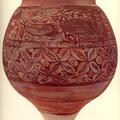"House 13 in the VS Area [of Mohenjo-daro] has a more elaborate plan . . . On its ground floor are four fair-sized courts, ten smaller rooms, three staircases, a porter's lodge, and a well-chamber.
344 posts, also carried on our Facebook page, about the ancient Indus Valley civilization, including important news, research and occasional visits to museums with ancient Indus artifacts.
Apr 12, 2014
This drama is depicted on at least two other seals from the ancient Indus metropolis. In other scenes from Harappa, this is a female deity standing on an elephant with a spoked wheel sign above her head (see Deity Strangling Tigers Tablet).
Asko Parpola
Apr 10, 2014
The grand and rare humped zebu (bos indicus) motif on a pot from Nausharo (ca. 2600-2500 BCE) and on a square steatite seal from Mohenjo-daro (ca. 2500 BCE). Note how similar they are.
The majestic zebu bull, with its heavy dewlap and wide curving horns is
Apr 8, 2014
Gold cap shaped ornaments from Harappa found in a hoard of jewelry from Mound F, Trench IV, House 2. Note the tiny hoops on the inside.
Apr 5, 2014
The dancing girl of Mohenjo-daro in three views, with close-ups of face, choker and bangles. John Marshall writes of this figure: "the arms and legs . . . are adorned with armlets, bangles, and anklets.
Apr 3, 2014
Harappa Mound AB Center with the great drain looking out over Punjab. Harappa was first excavated in 1872 by Alexander Cunningham, the original Director General of the Archaeological Survey of India.
Apr 1, 2014
The large horns could represent the power or virility of the animal; whoever wore the horns would possess similar attributes. According to J.M. Kenoyer, they may depict powerful hunters, shamans or even some form of water buffalo or cattle deity. Asko Parpola
Apr 1, 2014
An Indus feline figurine from Harappa. Among the dangerous wild animals represented in the figurine corpus are large wild felines.
Mar 29, 2014
1. The Great Bath at Mohenjo-daro, looking north.
Mar 27, 2014
One of the finest ancient Indus painted jars ever found, excavated at Chanhu-daro during the 1935-36 season led by Ernest MacKay.
Mar 15, 2014
The tomb of Baba Noor Shah, whose 9 meter long grave lies on Mound AB. By the entrance are singers, pipal trees and huge ancient Indus ringstones. The 17th century saint is said to have worn them on his toes.
See also Harappan Mounds #2.
Mar 13, 2014
"Indus beadmakers have the distinction of producing the longest and most slender beads of carnelian in the world, prior to the advent of diamond drilling," (J.M.
Mar 6, 2014
Seated faience monkey figurine or amulet from Mohenjo-daro. Its broken feet suggest that it was once attached to another object, possibly a second monkey as in the Triple Monkey Figurine. Molded and carved.
See also Monkey Figurine from Harappa
Feb 25, 2014
"The importance of females as symbols of religious power [in Indus Civilization] is supported by the fact that figurines of women or mother goddesses are more common than male figurines." (J.M.
Feb 22, 2014
What was the large pillared hall at Mohenjo-daro used for? The hall was approximately 27.5 meters square (90 feet square) with twenty square brick pillars arranged in four rows, only two of which are still preserved.















